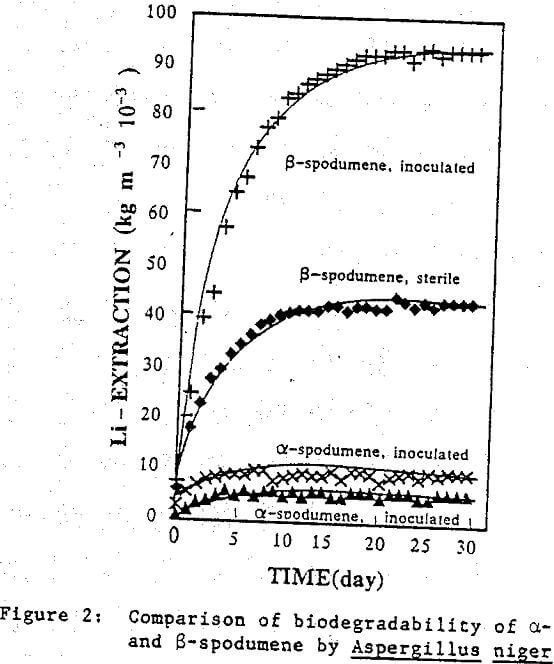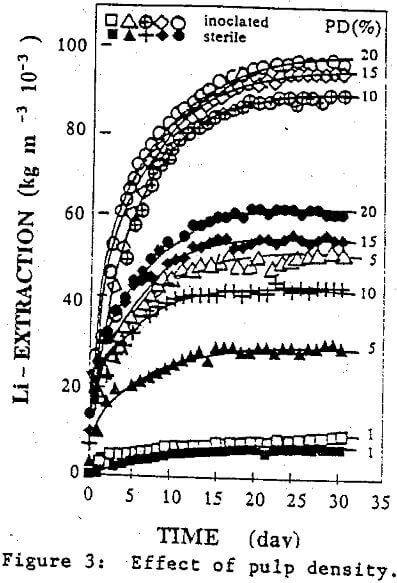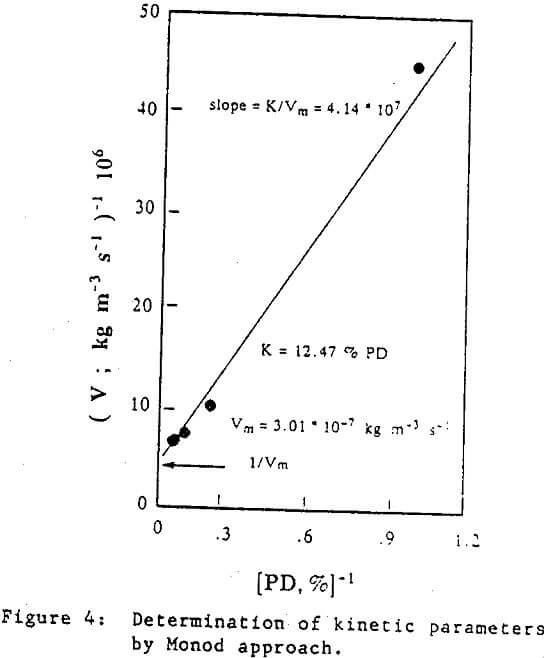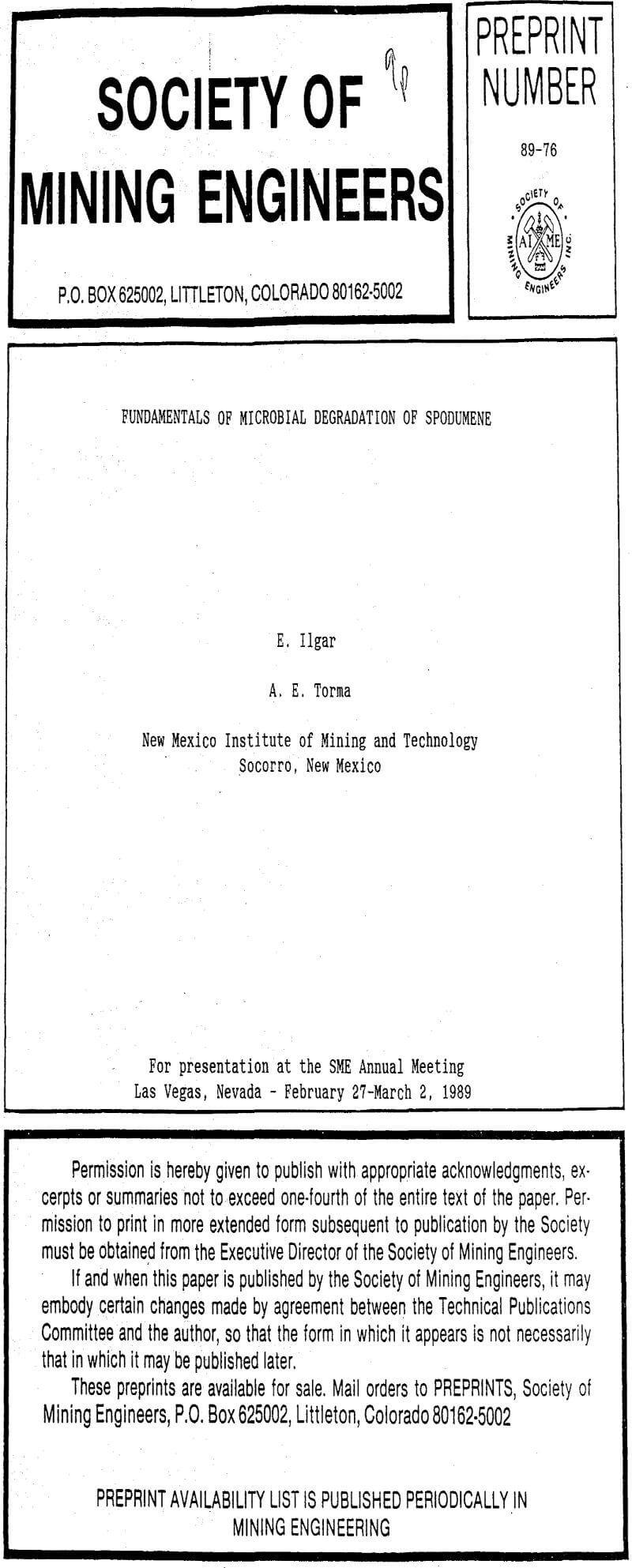Table of Contents
A culture of niger used in this study was obtained from Professor Stoyan Groudey of Higher Institute of Mining and Geology, Sofia, Bulgaria. It was maintained on Czapex-Dox agar medium (Booth, 1971) containing 100 x 10 -6 m³ distilled water, 3.0 x 10-³, kg sucrose, 0.3 x 10-³, kg NaNO3, 0.1 x 10-³ kg K2HPO4, 0.05 x 10-³ kg KCl, 0.05 x 10-³ kg MgSO4 and 0.001 x 10-³ kg FeSO4. The pH was adjusted to 6.5 with 0.1N HCl. Furthermore, mixture was autoclaved at 393 K (115 kPa) for 20 minutes, then cooled to 313 K. A 5 x 10 -6 m aliquot of this medium was introduced into 15 x 10 -6 m³ screw-capped presterilized tubes and the medium was allowed to solidify in a slanted (approximately 30°) position. These tubes were inoculated with loop fulls of a culture of A. niger and incubated at room temperature for 48 hours. Then the developed cultures were preserved in a refrigerator at 277 K and used for the preparation of microbial inoculum up to 1 month. After this one month period of time, the procedure was repeated to maintain the active culture in pure form.
Preparation of Experimental Inoculum
The inoculum of A. niger was prepared by adding a loop full of the preserved bacteria to 100 x 10 -6 m³ of sterilized liquid medium in 250 x 10 -6 m³ Erlenmeyer flask and incubated on a rotary shaker at 200 rpm for 48 hours at 294 K. After this period, 10 x 10 -6 m³ portions of these cultures were then used as inocula in the biodegradation studies.
Shake Flask Experiments
These series of experiments was carried out in 250 x 10 -6 m³ Erlenmeyer flasks containing 90 x 10 -6 m³ nutrient solution, 10 x 10 -6 m³ inoculum of niger, and various amounts of β-spodumene of 1, 5, 10, 15, and 20 g (1%, 5%, 10%, 15%, and 20% of pulp densities). These flasks were incubated on a gyratory incubator shaker (model 3250 of Labline Inc., Illinois) , at 294 K. In sterile control flasks, 10 x 10 -6 m³ of 2% solution of thymol in methyl alcohol was added instead of inoculum. Periodically, distilled water was added to the flasks to compensate water evaporation and a 3 x 10 -6 m³ sample was withdrawn from the flasks for analysis. This amount of sample was replaced with equal amount of nutrient medium. These withdrawn samples were filtered and analyzed for dissolved lithium contents on an atomic absorption spectrophotometer, Perkin Elmer, Model 703.
Tank Leaching Experiments
This, series of experiments was carried out to study the conversion of sugar to organic acids (citric and oxalic acids), leaching of β-spodumene with synthetic oxalic and citric acids and leaching with spent liquor from conversion of sugar by niger.
Biodegradation of Spodumene by Aspergillus niger
A preliminary experiment was carried out to assess the relative leachability of α- and β-spodumene. These experiments were carried out in 250 x 10 -6 m³ Erlenmeyer flasks which were charged with 1.0 x 10-² kg α- and β-spodumene, 90 x 10 -6 m³ nutrient solution and 10 x 10 -6 m³ inoculum of niger. The results obtained in these experimental runs are shown in Figure 2.

From this plot, it can be seen that the final lithium extraction was much higher for the leaching of β-spodumene than for that of the α-spodumene. These results indicate the relative inertness of α-spodumene or its high resistivity to biodegradation and/or to chemical attack. As a consequence, in the further studies only β-spodumene was used.
Effect of Pulp Density on the Biodegradation of β-Spodumene
These series, of experiments was carried out in 250 x 10 -6 m³ containing 90 x 10 -6 m³ nutrient solution, 10 x 10 -6 m³ inoculum of A. niger, and various amounts of β-spodumene of 1, 5, 10, 15, and 20 g (1, 5, 10, 15, and 20% of pulp densities) at 294-K. The results of these experiments are presented in Figure 3. From this plot, the highest lithium dissolution was found to be 101 x 10-³ kg m-³ that was obtained

with a 20% pulp density suspension. The rate of lithium extraction was found to increase with respect to pulp density as described by a hyperbolic type curve, that can be evaluated by the linearized Monod equation (Monod, 1949):

A plot of 1/V versus 1/[PD] gives a straight line as shown in Figure 4. The kinetic values (Vm) and corresponding constant K were calculated to be 3.01 x 10 -7 kg m-³ s-¹ and 12.47% PD, respectively. The highest experimental Vm

value was only about 1.56 x 10 -7 kg m-³ s-¹, that was obtained with a 20% pulp density leach suspension.

